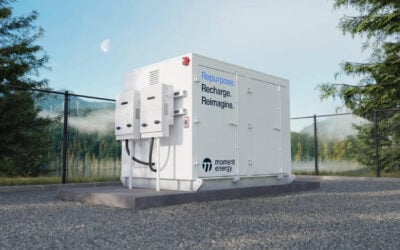A test centre at KIT, used as part of the Competence E programme on energy storage. Image: Karlsruhe Institute of Technology.
Making safe lithium-ion based home energy storage systems is not really a challenging prospect, but standards need to be adopted across the whole industry, German research and education institution Karlsruhe Institute of Technology (KIT) has said.
The institute has also developed a module assembly robot which automates some of the processes which in many cases are still being done by hand, with the aim of improving the quality of finished products and giving manufacturers the opportunity to mass produce their Li-ion battery cells.
Enjoy 12 months of exclusive analysis
- Regular insight and analysis of the industry’s biggest developments
- In-depth interviews with the industry’s leading figures
- Annual digital subscription to the PV Tech Power journal
- Discounts on Solar Media’s portfolio of events, in-person and virtual
Over the past year or so, there have been calls for manufacturers of energy storage systems at residential scale to develop better, more uniform guidelines or regulations on safety and performance. As well as reassuring the public and potential end-users, there is thought to be a strong case for ensuring all potential stakeholders including financiers and governments can recognise that lithium-ion batteries are a safe technology for the home.
“Last year we came up with a report on the safety of commercially available home systems, because we were very much concerned that some of the products could endanger the whole development of this very nice and interesting market,” Dr Olaf Wollersheim, team leader on KIT’s Competence E project to look at the energy storage industry as a whole.
“At the same time we made some proposals for increased safety measures. Together with the industry and leading industry associations, we’ve worked on safety guidelines for home storage systems and these have been published now and can also be certified by independent accredited test labs.”
The guidelines were issued last year and were supported by groups including German solar and renewable energy trade associations BSW Solar and Bundersverband Energiespeicher (BVES). They have been translated into English from the original German version as a courtesy to international readers, although the original language format is considered binding.
Wollersheim told PV Tech Storage at Intersolar Europe trade fair last week that KIT has also produced a module assembly robot, which automates the welding connections in the manufacturing of lithium-ion battery cells. A working version was put on display at the show, putting together a cylindrical module of battery cells.
KIT's module assembly robot for lithium-ion batteries, on display at Intersolar Europe. Image: Andy Colthorpe.
“
…Once we can assume that all storage systems are safe, the next question is, will they give to the customer the value that manufacturers are proposing?
For Wollersheim and his Competence E team, the development of a process that could improve quality of production as well as volume was the next logical step after ensuring safety- although the robotic production process can also improve this aspect as well, he said. Poor welding resistance can cause cells to overheat and affect the whole module in a chain reaction, “which is not easy to control,” according to Wollersheim.
“…Once we can assume that all storage systems are safe, the next question is, will they give to the customer the value that manufacturers are proposing?
“Here you can see [in the display] a module of cylindrical cells being manufactured by an automated welding process. This is very important because [in] many products, you find these welding connections being made by hand. So there is a wide variation of the contact resistance by these hand-made processes which is very bad for the quality and durability of the battery at the end.”
Back to the safety issue, Wollersheim said that actually, while the shortcomings in safety measures by some companies were a concern, the implementation of safe guidelines on a uniform basis should not prove in itself to be too difficult.
“The challenge is not too big in technical terms because it is well known what has to be done to make the system safe, it’s just that you should know it and you should implement it in your system. We were very much concerned about the [safety] deficits that we observed due to lack of competence in some manufacturers and this is closely connected with the effort in terms of money and personnel which was invested in the system to make it safe.”
Wollersheim said the safety guidelines are already “well distributed among the whole storage industry in Germany", but his team would like to see it brought in at a Europe-wide level “at least and ideally, worldwide”, he said.
Meanwhile, Wollersheim said, the robot is ready for action and could be deployed at a mass production line. KIT’s Competence E team has already created a 3D CAD sketch of a module production factory and is seeking partners, aiming to support companies that need to scale up.
“
Last year we came up with a report on the safety of commercially available home systems, because we were very much concerned that some of the products could endanger the whole development of this very nice and interesting market






